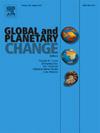地形改变了全新世中国东北地区泥炭地形成的最佳时机
IF 4
1区 地球科学
Q1 GEOGRAPHY, PHYSICAL
引用次数: 0
摘要
泥炭地是一种关键的碳汇,在全球碳循环和气候变化中发挥着重要作用。了解泥炭地的形成过程对于理解泥炭地的碳汇功能至关重要。虽然人们普遍认为气候是控制泥炭地形成的主要因素,但地形这一影响当地气候条件的限制因素的重要性仍不明确。在此,我们利用中国东北地区 231 块泥炭地的数据评估了地形对泥炭地形成的作用。结果表明,晚全新世期间形成的泥炭地大多分布在海拔200米(51%的地点)和坡度5°(44%的地点)的地区。泥炭地形成的最佳时机随着海拔和坡度的增加而推迟,我们推测其潜在原因是,海拔的增加导致温度降低,从而减缓了植被的生长。此外,较陡的斜坡不利于水分保持。坡度对泥炭地形成的影响很小,这很可能是因为不同坡度下太阳辐射的变化对当地环境因素的影响不大。本研究表明,对于全新世期间中国东北地区泥炭地形成的频率和最佳时间而言,海拔和坡度比坡度更为重要。本文章由计算机程序翻译,如有差异,请以英文原文为准。
Topography alters the optimum timing of peatland initiation across Northeast China during the Holocene
Peatlands are a key carbon sink and play an important role in the global carbon cycle and climate change. Understanding the process of peatland initiation is essential to understand the carbon sink functions of peatlands. While the climate is widely recognized as the main driver that controls the peatland initiation, the importance of topography, a limiting factor that influencing local climate conditions, is still unclear. Here, we used data from 231 peatlands in Northeast China to evaluate the role of topography on peatland initiation. The results show that most peatlands that initiated during the Late Holocene was distributed at elevations <200 m (51 % of sites) and slopes <5° (44 % of sites). The optimum timing of peatland initiation is delayed with increasing elevation and slope, and the potential reasons we speculated is that the increasing elevation slows vegetation growth owing to the decrease in temperature. In addition, steeper slopes are not conducive of water retention. There was little effects of slope aspect on peatland initiation, most likely because variations in solar radiation under various slope aspects may not have a substantial impact on local environmental factors. This study demonstrates that elevation and slope are more important than slope aspect on the frequency and optimum timing of peatlands initiation in Northeast China during the Holocene.
求助全文
通过发布文献求助,成功后即可免费获取论文全文。
去求助
来源期刊

Global and Planetary Change
地学天文-地球科学综合
CiteScore
7.40
自引率
10.30%
发文量
226
审稿时长
63 days
期刊介绍:
The objective of the journal Global and Planetary Change is to provide a multi-disciplinary overview of the processes taking place in the Earth System and involved in planetary change over time. The journal focuses on records of the past and current state of the earth system, and future scenarios , and their link to global environmental change. Regional or process-oriented studies are welcome if they discuss global implications. Topics include, but are not limited to, changes in the dynamics and composition of the atmosphere, oceans and cryosphere, as well as climate change, sea level variation, observations/modelling of Earth processes from deep to (near-)surface and their coupling, global ecology, biogeography and the resilience/thresholds in ecosystems.
Key criteria for the consideration of manuscripts are (a) the relevance for the global scientific community and/or (b) the wider implications for global scale problems, preferably combined with (c) having a significance beyond a single discipline. A clear focus on key processes associated with planetary scale change is strongly encouraged.
Manuscripts can be submitted as either research contributions or as a review article. Every effort should be made towards the presentation of research outcomes in an understandable way for a broad readership.
 求助内容:
求助内容: 应助结果提醒方式:
应助结果提醒方式:


